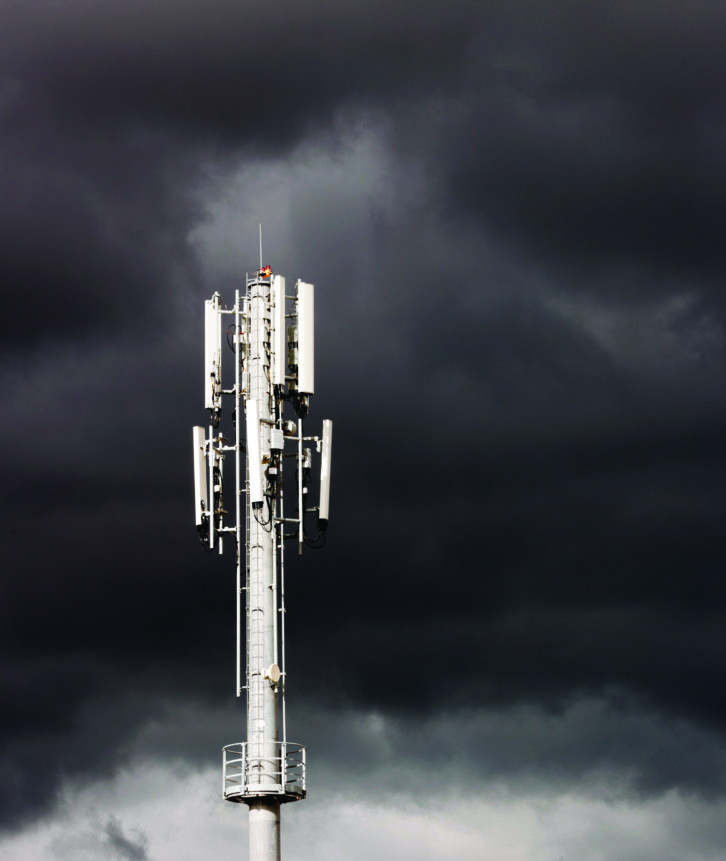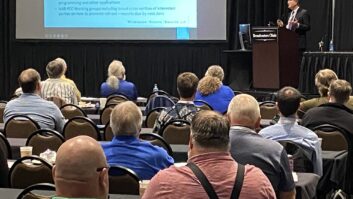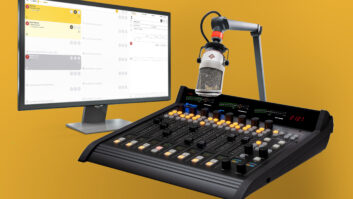Broadcasters have been watching developments in the FCC Resilient Networks rulemaking proceeding, which could eventually lead to more requirements for their participation in disaster recovery procedures.
The commission updated its rules in July, making wireless network resiliency cooperation mandatory for wireless carriers in the United States. They could do something similar for broadcasters.
The FCC introduced the Mandatory Disaster Response Initiative (MDRI), which largely codifies and builds upon an industry-developed Wireless Network Resiliency Framework.
That framework, which does not include broadcasters, was developed by a group of facilities-based mobile wireless service providers and had been endorsed by the FCC. The action extends the reach of the provisions to all mobile wireless providers to test their roaming capabilities and report on the performance of their implementation of the new MDRI.
DIRS and backup power

The Resilient Networks Report and Order adopted in late June seeks to improve the reliability and resiliency of wireless communications networks during emergencies. The FCC’s goal is to keep cell phones working and people connected when disasters like hurricanes and wildfires strike, the commission says.
“We’ve seen that the mutual aid and other provisions of this framework can be effective at speeding recovery and ensuring responders have all the information they need, and it’s time that these practices be implemented on an industry-wide basis,” said Chairwoman Jessica Rosenworcel.
However, the accompanying Further Notice of Proposed Rulemaking (FNPRM) examines broadcaster resiliency and any gaps that might need to be filled in the Disaster Information Reporting System (DIRS).
The original Resiliency Networks proposal considered changes to DIRS, which is a voluntary web-based system used by broadcasters since 2007 to report broadcast service outages to the FCC. The FCC proposal considered the possibility of mandatory DIRS reporting of outages for participants following a disaster.
The commission in July also renewed its inquiry examining the backup power status for communications facilities. The NPRM asked about ways to mitigate the effects of power outages on communications networks in the aftermath of disasters. The FCC in the proposal asked detailed questions about how backup power can be deployed to reduce the frequency of power-related service disruptions.
The FCC at least discussed adopting backup power requirements for participants in DIRS and NORS, the Network Outage Reporting System, in the original proposal.
“To the extent that the commission were to adopt backup power requirements, providers subject to them, potentially including cable providers, Direct Broadcast Satellite providers, Satellite Digital Audio Radio Service, TV and radio broadcasters, Commercial Mobile Radio Service and other wireless service providers, could potentially be required to take steps to make their networks more resilient to power outages,” states the FCC notice proposal, released in 2021.
And as recently as this summer when the latest rulemaking affecting wireless carriers was released, Rosenworcel indicated the FCC is still moving forward and looking at additional changes that will speed recovery efforts of communication networks following disasters.
“These changes will help restore service faster, help speed response coordination, and keep more people connected in disaster. But we can’t stop here. In the rulemaking we adopted last year, we looked at several other ways our disaster response playbook could be updated,” Rosenworcel wrote in a letter accompanying the rulemaking.
She continued: “We sought comment on where there are gaps that need to be filled in our Disaster Information Reporting System. We also renewed our inquiry into backup power for communications facilities as well as the essential intersection between modern communications and the electrical grid. We will continue to assess the record and work on these issues.”
[See Our Business and Law Page]
Prioritize broadcast infrastructure
The National Association of Broadcasters and state broadcasters’ associations have been active filing comments in the current proceeding and looking for any signs the FCC could be considering mandates on radio broadcasters.
NAB told the FCC mandatory participation for broadcasters in DIRS is unnecessary and wish for no additional rules regarding fuel backup during times of crisis.
“Broadcasters already participate in DIRS to the best of their ability and depending on their individual circumstances, have no objections to further voluntary coordination with other telecommunications providers during emergencies, and already install generators and maintain fuel reserves commensurate with their financial resources and likelihood of experiencing a prolonged power failure,” NAB wrote.
The FCC says DIRS participation increases its situational awareness following a disaster and gives it the ability to share status information with government partners.
If the FCC still believes that DIRS should be mandatory, NAB commented, perhaps the onus should be on government to create and fund an automated system that identifies which broadcast stations are operating during a disaster.
The broadcast advocacy group says the reliable nature of broadcast architecture allows it to continue service during a disaster even when the electrical grid, cellular service and the internet is down.
“For example, radio broadcast transmission facilities are designed with redundant systems and backups, auxiliary transmission sites, emergency power, and more, all with the goal of keeping stations on the air in all circumstances,” NAB says.
The association used the comment opportunity to ask the FCC to work with its government partners to prioritize the restoration of electricity to broadcasters, or alternatively, the delivery of fuel for generators.
“After local public safety and medical service providers, service to communications providers should be considered among the most critical functions as an electrical grid is repaired,” NAB declared. “The FCC should also consider ways to foster access by broadcasters to their studios and transmitters during times of crisis in a safe manner that does not impede emergency public safety and medical services.”
[Sign Up for Radio World’s SmartBrief Newsletter]
“All good here”
A number of state broadcast associations in joint comments reiterated many of NAB’s arguments against a mandate but went a step further in claiming making DIRS reporting mandatory for broadcasters would actually undercut the system and divert critical broadcast resources.
“Where a station is operational but running with a skeleton staff in a disaster area, stepping back from keeping the station operational, gathering news and emergency information, and getting that information to the public, merely in order to file a DIRS report saying ‘all good here’ diverts station resources with no upside for the public and a limited informational benefit to the FCC,” the broadcast associations told the FCC.
Meanwhile, National Public Radio went so far as to downplay the importance of DIRS in its comments to the FCC.
“Although public radio stations may be aware of DIRS, it does not appear to have been widely used by stations, if at all. Most stations do not experience extended service outages, primarily because of the extraordinary measures they take to maintain broadcast operations in the wake of a disaster,” NPR wrote.
Smaller radio broadcasters may also find DIRS difficult to use, according to comments by REC Networks, an LPFM advocacy consultancy. REC commented that small broadcasters are likely to only have access to smart phones with narrow screens if they need to access DIRS during an outage following a natural disaster of some sort.
“The current DIRS system is built on the commission’s legacy architecture and substantially uses tables and requests entries, such as geographic coordinates in decimal format.
“Because of the fact that the current DIRS system is not mobile-friendly and requires a significant number of entries to make a report, including information where accessing a different website may be necessary, this will make it difficult or in some cases, impossible for small radio broadcast stations to participate, voluntarily or mandatorily in DIRS,” REC told the FCC.
Still other viewpoints expressed in the resiliency proceeding discuss establishing cooperative efforts for mutual aid between local broadcasters, which could increase overall broadcaster resiliency through the sharing of backup power resources such as generators and fuel supplies.
Gary Timm, a public warning expert from Wisconsin, told the FCC much of that sort of contingency planning has been completed already.
“If the commission is truly interested in fostering this mutual aid among broadcasters, the FCC can rely on work done by its past Federal Advisory Committees, the Media Security and Reliability Council (MSRC). The MSRC priorities were developing plans for mutual aid among broadcasters (e.g., routing programming from Station A’s studio to Station B’s transmitter to keep programming on the air for the public) and second, to develop communications channels from emergency management agencies to local broadcasters to keep the official information flowing when normal communications are disrupted,” he wrote.
He concluded his comments: “The FCC relaunching the MSRC recommendations would support many aspects of Broadcast Resiliency raised in the NPRM.”
A comment period on the FNPRM (PS Docket 21-346) will commence following publication in the Federal Register.












